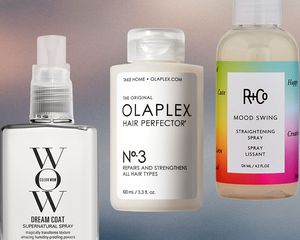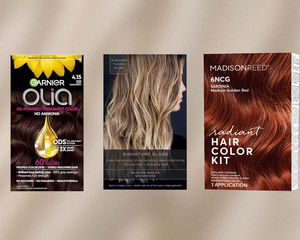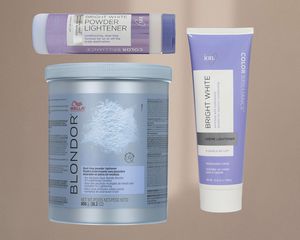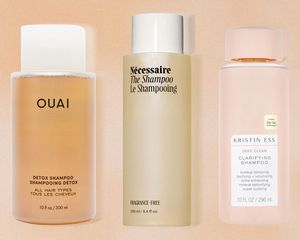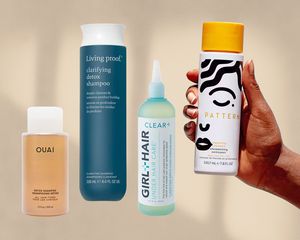
Unsplash
If you’ve ever hoped for smoother, frizz-free hair, chances are, you’ve heard of keratin hair treatments—or, at the very least, Brazilian blowouts. These smoothing hair treatments—which are one in the same—are known for their ability to make hair look straight, smooth, and shiny for up to six months. The only problem is, they’re loaded with chemicals and often get a bad rap as a result. Because of that, and knowing full well just how beneficial keratin can be on its own as a haircare ingredient, beauty brands have begun formulating keratin-infused at-home products.
What is Keratin?
“Keratin is a structural and protective protein that makes up hair and nails,” says cosmetic biochemist Stacey Steinmetz. “In hair, it’s responsible for preventing breakage, frizz, and heat damage. By applying keratin topically to your hair, it can be used to smooth and de-frizz.”
We tapped the experts to get the inside scoop about using keratin for hair, including the benefits, the different ways to use keratin and who it is most suited for.
Meet the Expert
- Stacey Steinmetz is a Cosmetic Biochemist and New Product Development expert. She is the founder of StimuNail.
- Dr. Hadley King, MD, FAAD, is a New York City-based dermatologist and adviser for Collective Laboratories.
- Gretchen Friese is a BosleyMD-certified trichologist in Denver, CO.
There are two main ways to add keratin into your haircare routine, and depending on which you choose, the benefits vary. “When hydrolyzed collagen proteins are applied topically on the hair, they can help fill in damaged areas of the hair shaft, temporarily boosting the strength,” says New York City–based dermatologist Hadley King, MD. “This is different from [in-salon] keratin treatments that generally feature formalin (formaldehyde and methyl alcohol) to straighten hair. Those treatments can damage hair and release dangerous fumes.” Despite those potential dangers, many people still book in-salon keratin treatments.
Ahead, find out the basics of the ingredient, including how it works to strengthen your hair and the best way to get all the benefits of keratin.
Keratin for Hair
- Type of ingredient: Strengthening smoother
- Main benefits: Repairs the hair shaft, smoothes strands, adds shine
- Who should use it: In general, keratin is most beneficial for those with thick, damaged, frizzy hair. Folks with fine, fragile hair may not fare as well.
- How often can you use it: At-home keratin-infused products can be used daily. In-salon chemical keratin hair treatments, however, should be scheduled only once every few months.
- Works well with: “Since keratin is a naturally occurring protein with smoothing benefits that minimize frizz and make hair glossy and manageable, other products can reinforce the benefits of keratin,” Steinmetz says, noting that natural oils like argan can help add moisture to damaged hair, and silicone-based finishing products can help further smooth the hair's surface.”
- Don’t use with: “If you have a salon keratin treatment in your hair, you need to stay away from sodium chloride, parabens, and sodium lauryl sulfates,” says BosleyMD-certified trichologist Gretchen Friese, noting that doing so will help maintain the integrity of the treatment. If you’re using gentler, at-home keratin-infused products, however, no ingredients are off-limits.
Benefits of Keratin for Hair
:max_bytes(150000):strip_icc()/GettyImages-595779-001-bd175c59a72044de8ff266cfbcfd797f.jpg)
Jerome Tisne / Getty Images
Before diving into the benefits of keratin for hair, let’s be clear on what keratin is and how it affects the hair. For starters, keratin is the cornerstone of hair structure. It’s a fibrous protein that quite literally forms each strand of hair. As hair becomes damaged, it needs all the help it can get to repair and boost its natural structure. Keratin treatments and keratin-infused products offer many benefits to your hair.
- Strengthens hair: Whether you opt for an in-salon or at-home keratin hair treatment, you can expect to notice a difference in your hair. “At-home keratin products help to strengthen hair that has been compromised by chemical and mechanical damage,” Friese says. In fact, research showed that keratin helped strengthen strands by 40%.
- Smooths hair and reduces frizz : Keratin infused products—which often come in oil or serum form–can result in a smoother, shinier, healthier-looking mane.
- Adds shine: As keratin helps smooth hair cuticles and fill in damaged areas in the hair shaft, it adds lots of shine to your hair. The results may be more dramatic with in-salon treatments, however at-home products also can create shiny and healthy-looking hair.
- Reduces the look of split ends: Keratin help strengthen and smooth hair cuticles back together, which reduces the look of split ends. Stronger strands mean less breakage which encourages hair growth.
- Decreases drying time: A keratin treatment actually reduces the porosity in your hair, which means less water is trapped inside the hair cuticles. This means that it can decrease blow-drying time by quite a bit.
Hair Type Considerations
Keratin treatments—at-home or in-salon—work best for people with dry, damaged, and overall unruly hair types. Additionally, Steinmetz says that keratin treatments can be great for folks looking to achieve a fuller look, as it’s said to bind to thin hair and give it a fuller look. Though, that’s somewhat of a double-edged sword because, as Steinmetz points out, fragile strands can be overwhelmed by the harsh chemicals within an in-salon keratin treatment, not to mention the heat damage required to seal it in.
As far as who shouldn’t get an in-salon keratin hair treatment, Steinmetz says pregnant people and folks with preexisting respiratory issues should steer clear. “Salon keratin treatments contain large amounts of formaldehyde,” she admits. “Some hairstylists have reported respiratory problems from handling the keratin treatment products and inhaling their fumes repeatedly over time. For that reason, pregnant women should avoid getting this treatment. People with a sensitivity to formaldehyde or respiratory problems should also avoid keratin treatments.”
That doesn’t mean you have to avoid at-home keratin treatments, though. After all, those are much safer and do not contain the chemicals and fumes associated with in-salon techniques.
That said, Friese points out that there is such a thing as too much protein. “If the hair is feeling dry after using a keratin product, stay away from that kind of treatment and use one with moisture instead,” she instructs.
How to Use Keratin for Hair
:max_bytes(150000):strip_icc()/GettyImages-1305062361-025d77937a44474fa9e22583559a8ad8.jpg)
Catherine Falls Commercial / Getty Images
There are several ways to use keratin for hair to get all the benefits, including stronger hair that is shiny and frizz free. As trendy and convenient as in-salon keratin treatments may seem, the amount of harm they can cause to your hair makes them simply not worth it. As a result, if you’re looking to smooth and strengthen your hair for special events or even daily occurrences, opting for safer, gentler at-home formulas is the way to go.
Steinmetz points out that there are shampoos, conditioners, and finishing products that apply a layer of keratin to the hair to temporarily make it look shiny and glossy, while reducing frizz—though the benefits are short-lived. That doesn’t make these at-home products undesirable though. After all, would you rather have to apply a product daily or weekly and enjoy healthy-looking hair, or get a one-time in-salon treatment with the potential to damage your hair and lungs in the process? Exactly.
Keeping all these thoughts in mind, here are several ways to use keratin in your hair.
- In-salon keratin treatment: In-salon keratin treatments (also called Brazilian Blowouts) use liquid keratin, chemicals, and high heat to seal the protein into the hair. “The results are temporary and typically last up to six months,” Steinmetz says. As previously mentioned, the problem is, in order to garner those benefits, you have to expose yourself to potentially harmful chemicals, which is why Brazilian blowouts often get a lot of flack. While in-salon keratin treatments are technically an option, more often than not, they’re not recommended.
- Smooth hair and add shine as a styling serum: A keratin-infused styling serum that is applied while hair is still wet will not only make hair shiny and smooth, but also cut down drying time. Friese recommends Keratin Complex Infusion Keratin Replenisher.
- Hydrating oil treatment: When used as an oil treatment, keratin is often mixed with other oils (such as Abyssinian oil or Argan oil) to not only smooth and de-defrizz, but also moisturize your locks. Friese says the L'ANZA Keratin Healing Oil Hair Treatment will help repair damaged locks.
- Use as a strengthening shampoo: You can also get all the strengthening and smoothing benefits of keratin in a shampoo. Hask Keratin Protein Smoothing Shampoo is one great option as it leaves your healthy and frizz free, and the clean formula doesn't contain harsh chemicals.
- Repairing hair mask: For ultra-dry and damaged locks, Friese recommends using a keratin-infused hair mask, such as Paul Mitchell Awapuhi Wild Ginger Keratin Intensive Hair Treatment, to help repair color-treated or heat damaged hair. On a weekly basis, apply this mask to wet hair and leave in for 5 minutes. Rinse out and style as normal.
